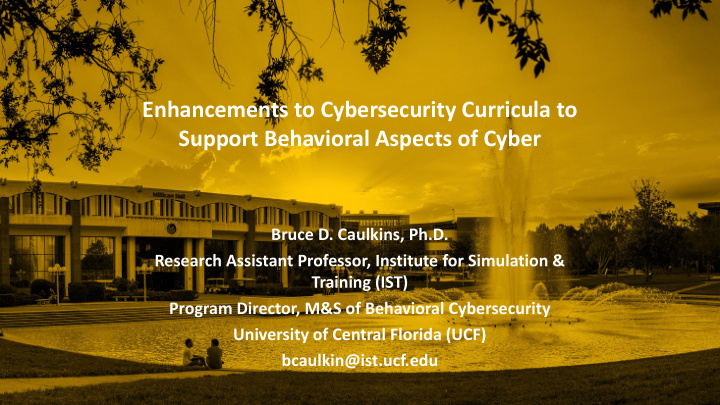



Enhancements to Cybersecurity Curricula to Support Behavioral Aspects of Cyber Bruce D. Caulkins, Ph.D. Research Assistant Professor, Institute for Simulation & Training (IST) Program Director, M&S of Behavioral Cybersecurity University of Central Florida (UCF) bcaulkin@ist.ucf.edu
People, Processes and Technology of Cybersecurity Education People Procs Tech
People, Processes and Technology of Cybersecurity Education People Important! But… Procs Tech
People, Processes and Technology of Cybersecurity Education People Procs Tech Laws, regulations, policy, etc…
People, Processes and Technology of Cybersecurity Education People Hackers, users, Procs Tech sysadmins, automation…
United States DoD Cyber Strategy Sets prioritized strategic goals and objectives for DoD’s cyber activities and missions to achieve over the next five years Focuses on building capabilities for effective cybersecurity and cyber operations to achieve success in DOD’s three primary cyber missions
DoD’s Three Primary Cyber Missions Defend DoD networks, systems, and information Defend the nation against cyberattacks of significant consequence Support operational and contingency plans
DoD’s Three Primary Cyber Missions The purpose of these principles and processes is to plan, develop, and use U.S. capabilities effectively, and to ensure that cyber operations occur in a manner consistent with the values that the United States promotes domestically and internationally.
DoD’s 5 Strategic Goals 1.Build and maintain ready forces and capabilities to conduct cyberspace operations 2.Defend the DoD information network, secure DoD data, and mitigate risks to DoD missions 3.Be prepared to defend the U.S. homeland and U.S. vital interests from disruptive or destructive cyberattacks of significant consequence 4.Build and maintain viable cyber options and plan to use those options to control conflict escalation and to shape the conflict environment at all stages 5.Build and maintain robust international alliances and partnerships to deter shared threats and increase international security and stability
DoD’s 5 Strategic Goals 1.Build and maintain ready forces and capabilities to conduct cyberspace operations 2.Defend the DoD information network, secure DoD data, and mitigate risks to DoD missions 3.Be prepared to defend the U.S. homeland and U.S. vital interests from disruptive or destructive cyberattacks of significant consequence 4.Build and maintain viable cyber options and plan to use those options to control conflict escalation and to shape the conflict environment at all stages 5.Build and maintain robust international alliances and partnerships to deter shared threats and increase international security and stability
UCF and Cybersecurity UCF is a 3x winner of the U.S. National Collegiate Cyber Defense Competition (2014 to 2016); placed 2 nd in April 2018 - http://www.nationalccdc.org/ Hack@UCF club has over 300 members In 2016, UCF was designated as a National Center of Academic Excellence in Cyber Defense Education (CAE-CDE) and Research (CAE-R) – robust tech side to cyber education UCF is a strong collaborative research university in Modeling & Simulation (M&S), computer science, engineering, digital forensics, Big Data, & human factors In 2015, UCF started a first-of-its-kind program in the graduate-level M&S of Behavioral Cybersecurity UCF’s cyber cluster on campus for faculty, cuts across disciplines: http://cyber.cecs.ucf.edu/
Fall 2015… UCF decides to look at the behavioral, “people” side of • cybersecurity education and training Created the “Modeling and Simulation of Behavioral • Cybersecurity” graduate certificate program Three cohort/groups so far • Focused on cognitive aspects • Students come from all areas •
M&S of Behavioral Cybersecurity Cybersecurity for M&S: Cyber ranges Behavioral Aspects of M&S: M&S Anomaly detection Training & performance Cyber aptitude Interdisciplinary methods testing for problem solving Attack vector Cognitive modeling simulation HF Cyber Team performance Behavioral Aspects of Cybersecurity: Insider threat detection Cyber workforce development Cyber team dynamics Hacker motivations
M&S of Behavioral Cybersecurity Graduate Certificate • 15 credit hours, 5 courses – currently in “3 rd cohort” of students • Combined “mixed” mode and online sections: “Mixed” mode is delivered face-to-face Online section as well, both synchronously or asynchronously • Starts every Fall Term and ends the following Fall Term Fall 2018 Spring 2019 Summer 2019 Fall 2019 IDC 6600 IDC 5602 CNT 5410L IDS 6941 IDC 6601
M&S of Behavioral Cybersecurity Graduate Certificate IDC 5602 Cybersecurity: A Multidisciplinary Approach (Fall) – Intro course; IDC 5602 M&S fundamentals as applied to cybersecurity CNT 5410L Cyber Operations Lab (Spring) – Hands-on, lab-based approach CNT 5410L to learning cybersecurity operations IDC 6601 Behavioral Aspects of Cybersecurity (Summer) – Focuses on IDC 6601 human, social, and behavioral issues related to cybersecurity IDC 6600 Emerging Cyber Issues (Summer) – Discusses emerging topics in IDC 6600 cybersecurity by examining current events and coordinating guest speakers from expert leaders in industry IDC 6941 Capstone in M&S of Behavioral Cybersecurity (Fall) – Capstone IDS 6916 course, group assignments covering all subjects in certificate
Future Work Continue work at UCF Expand to other universities in US and elsewhere (Howard Univ , …?) Work with academic agencies at state, federal, international levels (FC2) to expand reach Collaborate!!! International, federal, industry, academia
Enhancements to Cybersecurity Curricula to Support Behavioral Aspects of Cyber Bruce D. Caulkins, Ph.D. University of Central Florida (UCF) bcaulkin@ist.ucf.edu
Recommend
More recommend